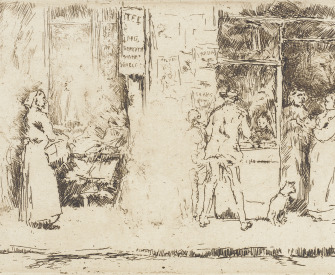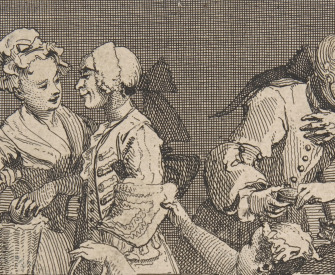I even gave up, for a while, stopping by the window of the room to look out at the lights and deep, illuminated streets. That’s a form of dying, that losing contact with the city like that.
—Philip K. Dick, 1972Waste Management
A journey through New York’s cesspool system.
For thousands of years, Homo sapiens flocked across continents in pursuit of bird, beast, and fresh water, leaving behind him a trail of gnawed bones and steaming waste. The moment we stopped removing ourselves from that waste, it had to be removed from us. Thus the origins of civilization, thus the glories of Rome, Paris, and Philadelphia. A civilization that cannot escape its own fecal matter is a civilization in trouble—unless, of course, the uneasy relationship between man and his effluents can evolve.
“The first regulations with respect to waste go back to the code of Hammurabi,” said Steve Askew, superintendent of New York’s North River Wastewater Treatment Plant, one of the world’s largest. “You have to bury your waste far from where you sleep.” And he gave me the look. Steve Askew never finished college, but that look had seen to the bottom of things. It was both spooky and intimidating, that particular look of pity and loathing the wise bestow upon the ignorant. He knew something I wanted to know: the ultimate fate of our waste.
“People wake up in the morning, they brush their teeth, flush the toilet,” said Askew. “They think it goes to the center of the earth.”
If you happen to live within one particular 5,100-acre patch of the West Side of Manhattan, instead of going to the center of the earth, your waste flows to Askew’s extraordinary concrete cesspit: twenty-eight concrete acres suspended above more than two thousand concrete caissons sunk into the shallows between the West Side Highway and the Hudson River. Constructed in the 1970s, topped by three swimming pools, a skating rink, and a carousel, North River cost the city a billion dollars, 100 million of which went straight into odor control.
North River is just one of New York City’s fourteen wastewater treatment plants, the first of which opened in 1886, along with the Statue of Liberty. These plants handle every conceivable kind of sewerable waste from the city’s eight million permanent residents, not to mention anything a commuter or a tourist might care to add. They separate the material that comes their way into solid, liquid, and gaseous parts, which they further subdivide into that which must be discarded, that which may be consumed, and that which someone, somewhere, might eventually be able to sell.
The substance that enters North River is mostly water, and the vast majority of that water leaves the plant after not much more than six hours, disinfected to the extent that it can merge inoffensively with the Hudson River. One flush on the Upper West Side at seven in the morning, and by three in the afternoon the water is back on the street, so to speak. What’s left over is a half-million gallons of concentrated daily waste, now known as sludge.
I followed Askew into an enormous room of computers, controls, workstations, and switches. Behind us flashed a wall-size diagrammatic panel, the great computerized brain of waste. Next to us stood the oiler, who had been at North River twenty years.
“Right now we’re at 135 million gallons per day,” said the oiler.
The greatest increase occurs between eight and nine in the morning, when the city’s output swells from 70 million to 150 million gallons per day. This is known as the big flush. Now it was eleven a.m., and in a few hours the circadian flow of biology en masse would begin to diminish, eventually bottoming out around four in the morning, at 68 million gallons per day. The rhythm is as steady as the tides. “The Super Bowl halftime surge is a myth,” said Askew.
He led me across the concrete floor, through a concrete warehouse, and to the concrete screening room, where he began to extol the virtue and beauty of his eleven-mile-long sewage interceptor. By the time the morning flush finally rolls into North River, it has joined the downstream flow of all the other morning flushes from all the other sewage lines from Bank Street to the Upper West Side, and sunk fifty-four feet below sea level. It is here, at the extreme low point of this immense underground current, that North River gets to work. In the Stygian depths, its mighty diameter swollen to sixteen feet, the dark torrent branches into six channels, each of which must be pumped to the top floor of the plant, where gravity can once again take hold and set the outcast on a new journey.
Askew gazed into the inky pool of untreated wastewater and began to describe some of the marvels the interceptor had disclosed. Aside from the daily take of leaves, sticks, cans, and paper, the great rake had brought up quite a few vials of cocaine. When cops bang on the door, the toilet is a drug dealer’s best friend. Ditto for the professional forger: a good deal of counterfeit money has floated into Steve Askew’s hands. Twenty years ago a dog showed up, a living dog that became the mascot of a Brooklyn plant.
As we walked away from the pool, I asked about the wind. No matter what the weather is outside, no matter where we traveled inside, the thick concrete walls of North River generated bracing gusts. Askew explained that every minute, titanic blowing machines inhaled 600,000 cubic feet of fresh air and exhaled 750,000 cubic feet of carbon-filtered, bleach-scrubbed exhaust—six to twelve complete air changes per hour.
But the scouring of North River’s halitosis, while essential to community relations, has nothing to do with the plant’s core mission. The alchemy of purgative transformation starts in the warmth and humidity of the next chamber we visited, where submerged chemical mixers combine the waste with custom-made bacteria. “It’s volatizing off!” Askew yelled above the din of engines and bubbling brown water. Undeterred by the general uproar, Askew detailed the technical intricacies of fecal breakdown and development, but I’m afraid the cacophony blunted the nuances. So Askew dumbed down the lecture. “This looks really good!” he hollered. “Tan water! Light brown froth! Small bubbles! Musty smell! If the foam looks like chocolate mousse, that’s an indication of a bacteriological process!”
We headed to a low-ceilinged room so huge it did not appear to have walls. Here were the settling tanks, the final stop before the water returned to the world. Peace held sway among these last lagoons, and indistinct reservoirs misted into a concrete vanishing point hundreds of yards away. “On a cold morning, you will see the water vaporing off,” Askew said. “And it will rain inside the plant.”

The Conquest of Naples by Charles of Durazzo, by Master of Charles of Durazzo, 1381–82. The Metropolitan Museum of Art, Rogers Fund, 1906.
He gave me the look. “When it is really cold, it snows inside the plant.”
At that moment, two square football fields of submerged jets spumed into the shadows and the bronze liquid arced, more sublime and terrifying than the fountains of Trevi or Versailles. Soon these waters would sluice down concrete courses to mix with the mighty Hudson. As for the remaining sludge, it also would depart, but by an altogether different route.
When the froth finally settled back into silence, Steve Askew backtracked through the concrete dungeons until we arrived at a perfectly normal conference room and a nice surprise—someone had ordered pizza!
Despite the skating rink and swimming pool, despite the bleach, the carbon filters, the white hard hats and the spotless lab coats of the technicians, despite the banks of UNIX computers and the sober talk of asymptotes and oxygen demand, despite the boardroom-size wood-veneer table and the well-upholstered ergonomic chairs and the rush of twenty thousand cubic feet of air per second, and despite, to put it bluntly, one of the most extraordinary concealments in all of human history, North River still managed to evoke unappetizing associations. But as I gazed at the cheese and red sauce and blackened crust, I recalled the words of one of the many wastewater professionals I had met that morning. “One of the things about the job—you still have to eat.”
So I sat down to lunch and learned about the glorious future of waste. Now that biochemists could scour the particles on the atomic level, the plant could recover ibuprofen, acetaminophen, endocrine disrupters, DEET, Prozac, and Chanel No. 5. Even caffeine could be extracted from the mix, and I had a hunch the citizens of New York excreted boatloads of stimulant. Perhaps Starbucks would be interested. The technology was there.
“Twenty years from now we will be removing things we have no idea about,” said Askew. “Penicillin, mercury, heroin. Will this be a pharm business? An energy business? An agribusiness?”
He took another bite and delivered the look.
“A bear goes in the woods and it takes two years to decompose. We do it in six hours. In six hours, we imitate all of nature—from the big bang to the big chill. We’re trying to put it back the way that God intended.”
© 2008 by Frederick Kaufman. Used with permission of Frederick Kaufman.

Frederick Kaufman
From “Wasteland.” Kaufman is a contributing editor at Harper’s Magazine and teaches at the City University of New York and its Graduate School of Journalism. Fascinated by all things gastronomic, he once explained, “I’m interested in how our autonomic nerve system governs our decisions. A great deal of this connects to the stomach.”


